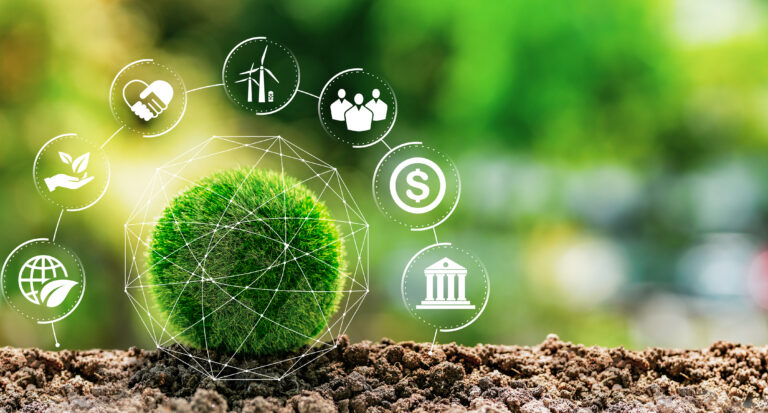July 17, 2023
Blog
7 Ways AI Can Be Used for Social Good
Artificial intelligence (AI) is fundamentally transforming our workforce by streamlining day-to-day operations and increasing worker productivity as well as overall job satisfaction. While some view this technology as a disruptive force set to automate creativity and displace workers, many more view the wide-scale adoption of AI as an opportunity to affect positive change on a global scale.
As communities, we can harness the power of AI to address worldwide challenges; we are now able to use AI as a tool for many forms of empowerment.
This article will examine ways AI can aid humanitarian efforts in the future—including environmental, economic, and communal health disparities. It will also offer several real-world examples of ways AI is currently being implemented to improve quality of life and create a more hospitable global ecosystem.
7 Examples of AI for Social Good
AI’s integration into daily life presents an incredible opportunity to assess how we manage global problems. Here are seven examples of AI applications for social good.
1. Crisis Response
Responding to large-scale disasters presents a challenge to safety management teams. AI can help them navigate and respond to emergencies more efficiently.
For example, Microsoft’s Azure Digital Twins technology facilitates emergency responses by identifying infrastructural damage in the wake of, for example, an earthquake or flood, helping direct first responders to all available building entrances so that they may avoid blocked doorways and triage patients quicker.
At Stanford, researchers have used AI to map fuel moisture as a method for predicting wildfires before they spread across the region, which can help reduce displacement patterns and the long-term economic impact of wildfire damage.
2. Education and Learning
AI has made promising strides in revolutionizing the education industry. For example, intelligent tutoring systems offer students personalized teaching instructions and study strategies.
AI can also automate non-teaching activities that are taxing for educators. It can grade tests, fill out paperwork, and organize lecture materials, allowing teachers to focus more closely on student needs.
3. Environmental Protection
AI systems can help us improve measures to minimize environmental and ecological devastation, including reducing greenhouse gas emissions.
Technological applications like the World Environment Situation Room use sensor data to provide real-time assessments of Co2 atmospheric concentration levels and sea level rise.
AI’s numerous capabilities can also reduce between 2.6 and 5.3 gigatons of carbon dioxide emissions, as reported by the Boston Consulting Group.
As upgrades and technological applications evolve, we should expect better systematic solutions for mitigating climate threats.
4. Health Treatment
With the help of AI technology, we can develop strategic methods for addressing systemic issues within the healthcare system.
For example, Google’s AI system can predict heart disease by using retinal images and examining risk factors, including age, blood pressure, and smoking habits.
Cancer care is another area where AI shows promise. Research demonstrates that AI prediction tools can provide us with better assessments of cancer-related outcomes in Africa. While research is still relatively new, we can expect AI to mark its influence.
5. Food Security
According to the World Health Organization, approximately 828 million people suffered from persistent food insecurity in 2021.
The good news is that there are systematic AI-facilitated efforts in place to ameliorate the circumstances that fuel food insecurity. The Nutrition Early Warning System, for example, uses satellite data to assess vegetation health and predict the value of crops.
HungerMap LIVE operates as a real-time hunger-monitoring system that uses predictive analytics to anticipate food insecurity. It combines multiple data sources, including weather, population size, and nutrition, to help us understand the forces that contribute to food insecurity patterns.
6. Language and Speech Modifications
AI-powered speech tools are becoming increasingly beneficial for addressing language barriers and speech pathologies.
Facebook has made great strides in teaching AI to translate spoken and written languages in real-time. Their Universal Speech Translator uses AI to provide immediate speech translations between multiple languages.
Another notable AI tool is Timlogo. The system operates as an interactive platform to diagnose speech-related concerns in children while recommending lessons that could minimize future difficulties.
7. Waste Reduction in Manufacturing
Modern AI inspection solutions can detect manufacturing defects before they accumulate and result in unnecessary expenses for the manufacturer. As quality control tools, they use datasets that generate alerts when irregularities in process occur.
Combined with an investment in mixed reality solutions, you can now tailor your AI systems to solve future manufacturing challenges, including waste reduction.
Shape Your AI Technology with Nanotronics
Using artificial intelligence for social good is about harnessing technological power to improve global welfare. With proper parameters, innovative upgrades, and a committed mindset, we can shape the future of AI’s trajectory and use its capacity as a force for good.
If you want to learn more about AI solutions for the manufacturing industry, Nanotronics is ready to take your call. We offer self-improving AI systems that allow for real-time correction, ultimately reducing waste and harmful emissions. Now you can streamline production processes while contributing to a greener future for all.
Check out our product pages to familiarize yourself with our offerings. Contact us to get started.

